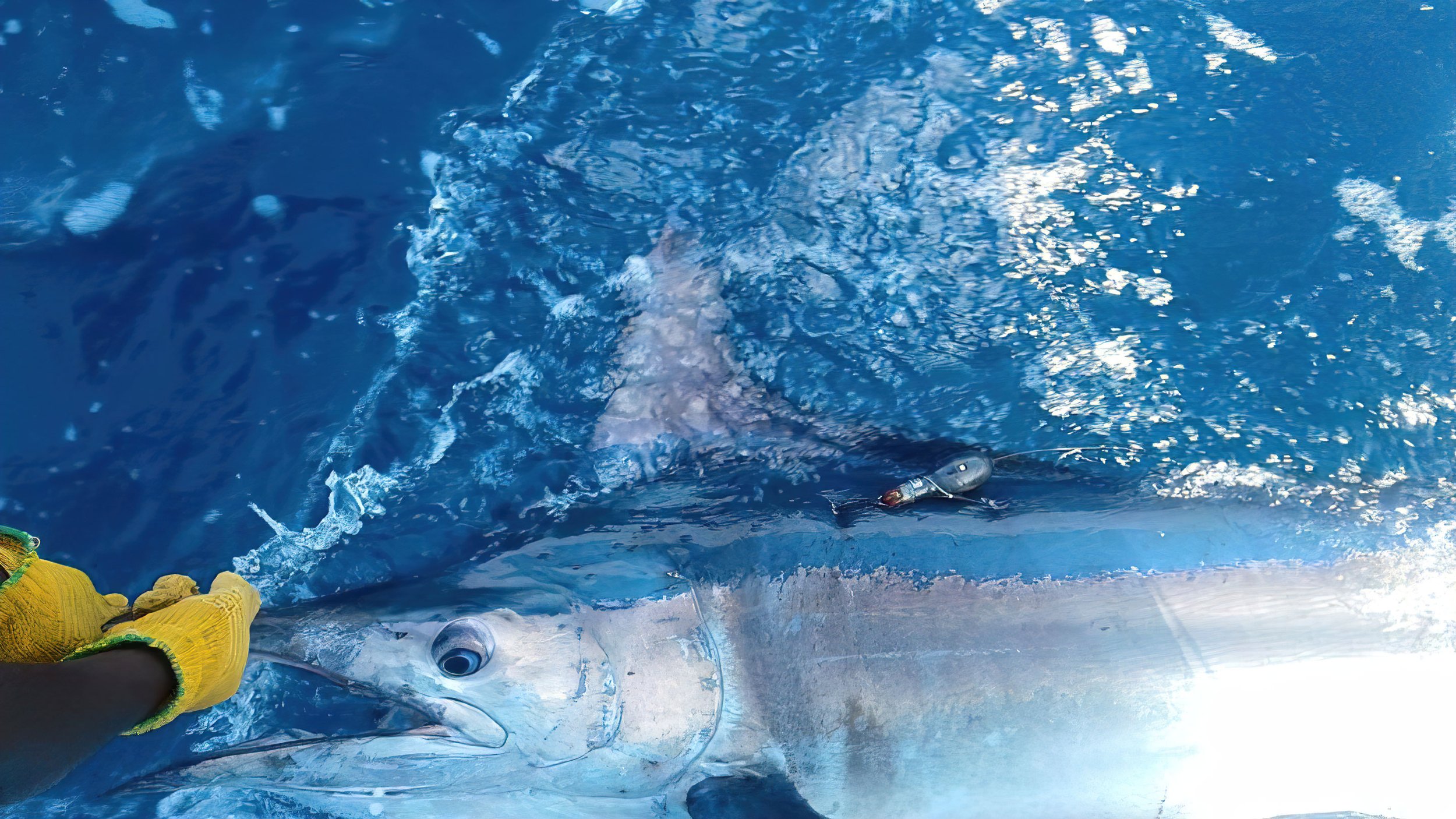
Mozambique Projects.
Black Marlin
What’s this project about?
Black marlin (Istiompax indica) are highly migratory apex predators and one of the world’s largest teleost fishes. Fisheries pressure in the Indian Ocean is increasing, but management initiatives are limited.
A lack of information on connectivity and population structure hampers progress. Mozambique’s coastline hosts a globally important critical habitat for these impressive fish.
Our research will use multiple methods to collect much needed data on the regional movements and population structure of black marlin and confirm the Bazaruto Seascape as the Indian Oceans’ first identified spawning grounds for black marlin.
Key successes to date
We officially launched our Marlin Project in the Bazaruto Seascape October 2022
We collected 21 tissue samples from individuals as we begin building our genetic library for the species in Mozambique
We successfully tagged the first marlin in the Bazaruto Seascape in November with 2 miniPAT satellite tags placed on 400 and 500 lb black marlin


Project Overview.
Black marlin are one of the largest teleost fishes, with females weighing over 700 kg/1000lb. They are highly mobile apex predators, and an important part of the structure and functioning of healthy marine systems. However, the movement ecology of black marlin in the Indian Ocean is poorly understood and few management measures of any kind have been implemented as a result.
Food and Fishing
Black marlin contribute to livelihoods and food security through artisanal fisheries, and their large size and ‘fighting qualities’ also make them one of the most prized trophy targets for recreational fishers. Recreational sport-fisheries in Mozambique are primarily catch-and-release, and make significant contributions to the tourism industry. They are also an important source of valuable billfish behavioural data. Increased billfish landings in the commercial sector over the last decade have raised concerns, and deep freeze long-liners off the coast of Mozambique have been highlighted as a developing fishing industry to watch. Additional knowledge about how black marlin use and move around the Mozambican coastline are sorely needed to ensure a sustainable future for the species, and all those that depend on them.
Black marlin in Mozambique
The Bazaruto Seascape region sees large, potentially gravid, female black marlin, visiting almost exclusively from October – December: a high seasonal density that are frequently caught by experienced fishers. Sport fishers travel internationally to this global hotspot to fish for these large record-breaking marlin in season. Resident experienced billfish fishers, as well as global experts, believe this area could be a spawning ground for this species. If confirmed, this would be the first identified spawning ground for black marlin in the whole of the WIO. As such, this region presents a unique opportunity to study this iconic, data-deficient species in what is likely to be a highly sensitive and important habitat to the wider black marlin population.
MMF research
Previous billfish satellite tagging work by MMF in Kenya, and large-scale genetics projects suggest that there is a highly interconnected population of black marlin in the WIO. However, what is still unclear is how the marlin use the coastline in Mozambique and how best to protect them while they are here.
Objectives.
Our researchers are collaborating with the regions’ most skilled billfish fishers as well as world experts on each aspect of this project to ensure we have the necessary data to inform robust management plans.
Satellite Tagging Black Marlin & NextGen Sequencing
We aim to conduct an integrated study which will include deploying satellite tags to track their movements, using NextGen sequencing techniques to investigate the fine-scale genetic structure of the population, and a multi-method approach to investigate marlin spawning behaviour in the region.
WILDLIFE Computers Satellite tag technology
Tags can be programmed to track movements for up to two years in the open ocean.
Tags are mini-computers, built to withstand pressure up to 2 km deep.
Tag records data every 3-5 seconds:
Light-level (used to calculate location)
Temperature
Depth (pressure)
Data is then summarized and stored in the tag until it releases.
We program the tags to release after 120 days, float to the surface, and upload data summaries to Argos satellites that are then sent to researchers. If we are lucky enough to recover the tag, we can download even more detailed datasets.
Satellite tag technology, shown attached, below.

Project Leaders.
Dr Clare Prebble
Project Leader, Senior Scientist
Clare started working with MMF in 2011. Her research focuses on using biochemical techniques and demographic data to find out about the dietary and movement ecology of megafauna species and understand their conservation needs.
Dr Chris Rohner
Principal Scientist
Chris is a principal scientist at MMF and an international expert in satellite tracking and population modeling, having worked on projects for over a decade. Chris was the lead scientist on the Kenya marlin project.
Collaborators.
Duarte Amador Moreira Rato – Fish Bazaruto. Expert gamefish fisherman
Morgan O’Kennedy – Big Blue Vilankulo. Expert gamefish fisherman
Roy Bealey – Pelagic Fisheries Consulting Ltd, Chairperson for the IGFA
Dr Samuel Mackey Williams – Dept. Agriculture Australia. Billfish Expert.
Support this project.
Help fund this project by sponsoring satellite tags at $5,000 each, with a goal of 10 tags in total. Smaller amounts are hugely appreciated and help to fund essential project expenses like boat hire, fuel, and scientific analysis.
Here, you can donate and receive an instant receipt.
The form accepts donations via credit card, PayPal, or direct bank transfer, in multiple currencies.
NOTE: Bank transfer is typically the best for larger amounts, as transaction fees are capped and not a % of the amount being donated.
If you prefer to process your donation via direct bank transfer, please contact Clare who can provide account details.
Questions?
Contact Project Leader, Dr Clare Prebble:
WhatsApp: +258 841 178 789
Email: clare[@]marinemegafauna.org





